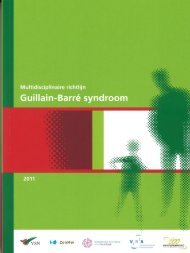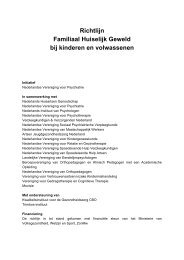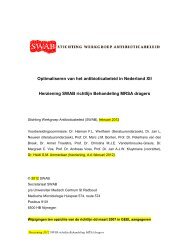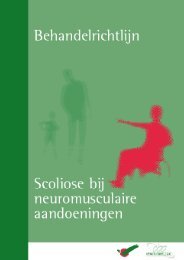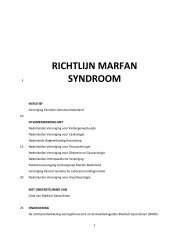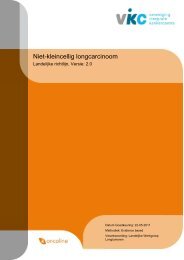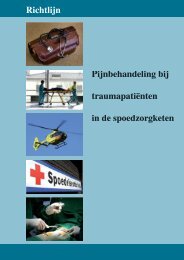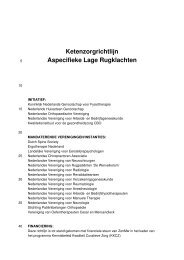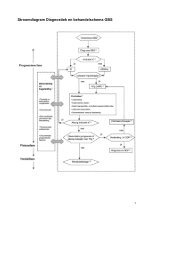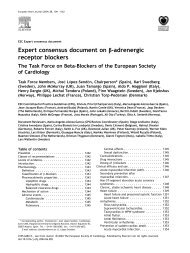Richtlijn: Otitis Externa - Kwaliteitskoepel
Richtlijn: Otitis Externa - Kwaliteitskoepel
Richtlijn: Otitis Externa - Kwaliteitskoepel
You also want an ePaper? Increase the reach of your titles
YUMPU automatically turns print PDFs into web optimized ePapers that Google loves.
Behandeling<br />
Uitgangsvraag 3<br />
Wat is de geïndiceerde behandeling van acute otitis externa?<br />
Onderbouwing<br />
The recommendation for initial topical therapy applies to the otherwise healthy patient with diffuse<br />
AOE that is not complicated by osteitis, abscess formation, middle ear disease, or recurrent episodes<br />
of infection. Topical therapy should be supplemented by systemic antibiotics if the affected<br />
individual has a condition, especially diabetes that is associated with markedly increased morbidity,<br />
or HIV infection/ AIDS or other conditions with immune deficiency that could impair host defenses; if<br />
the infection has spread beyond the confines of the ear canal into the pinna, skin of the neck or face,<br />
or into deeper tissues such as occurs with malignant/necrotizing external otitis; or if there is good<br />
reason to believe that topical therapy cannot be delivered effectively (see section 6, application)<br />
(Rowlands 2001, Zikk 1991). There is no trial to evaluate the efficacy of cleaning of the ear canal,<br />
whereas cleaning and placebo drops only achieves a cure rate of 10% (Kaushik 2010).<br />
Topical preparations are recommended as initial therapy for diffuse, uncomplicated AOE because of<br />
safety, efficacy over placebo in randomized trials, and excellent clinical and bacteriologic outcomes in<br />
comparative studies. There are no data on the efficacy of systemic therapy alone with the use of<br />
appropriate antibacterials and stratified by severity of the infection. Moreover, orally administered<br />
antibiotics have significant adverse effects that include rashes, vomiting, diarrhea, allergic reactions,<br />
altered nasopharyngeal flora, and development of bacterial resistance (Doern 2000, McCormick<br />
2003, Schrag 2004, Pottumarthy 2005). Societal consequences include direct transmission of<br />
resistant bacterial pathogens in homes and child care centers (Levy 2002).<br />
Topical antimicrobial treatment vs placebo<br />
Three randomized trials have compared topical antimicrobial vs placebo for treating diffuse AOE<br />
(Cannon 1967, Cannon 1970, Freedman 1978). Meta-analysis of the 2 trials with similar methods<br />
(Cannon 1967, Cannon 1970) yields a combined absolute rate difference (RD) of 0.46 based on 89<br />
patients (95% CI, 0.28 to 0.63), which suggests that only 2 patients needed to be treated (NNT) with<br />
topical antimicrobial to achieve 1 additional cure. Bacteriologic efficacy (RD, 0.61) was higher than<br />
clinical efficacy. Another trial (Freedman 1978) reported significantly less edema and itching 3 days<br />
after therapy was initiated, and less edema, itching, redness, scaling, and weeping 7 days after<br />
therapy was initiated.<br />
Topical vs systemic antibiotics<br />
No randomized, controlled trials have directly compared oral antibiotic therapy alone, with topical<br />
therapy. Reviews of survey data, however, show that about 20% to 40% of subjects with AOE receive<br />
oral antibiotics, often in addition to topical antimicrobials (Rowlands 2001, Halpern 1999, McCoy<br />
2004). Many of the oral antibiotics selected are inactive against P aeruginosa and S aureus, the most<br />
common pathogens identified in cases of AOE. Further, treatment with penicillins, macrolides, or<br />
cephalosporins increases disease persistence (rate ratios, 1.56 to 1.91), and treatment with<br />
cephalosporins also increases recurrence (rate ratio, 1.28; 95% CI, 1.03 to 1.58) (Rowlands 2001).<br />
Topical + systemic antibiotics vs topical antimicrobial + placebo<br />
One study is comparing oral antibiotics (amoxicillin) and topical (non-quinolone) antibiotic/ steroid<br />
drops with topical (quinolone)/ steroid drops (Roland 2008), and found no difference between<br />
groups. In an additional study (Yelland 1993) patients were randomized to topical ointment plus oral<br />
antibiotic (trimethoprim-sulfamethoxazole) vs topical ointment plus placebo; there was no significant<br />
21 <strong>Richtlijn</strong> <strong>Otitis</strong> <strong>Externa</strong> 2010<br />
Nederlandse Vereniging voor Keel-Neus-Oorheelkunde en Heelkunde van het Hoofd-Halsgebied




